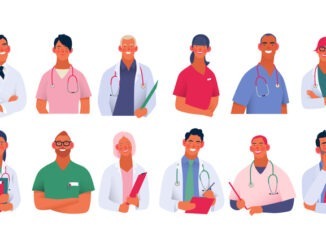
Now is the time to invest in general practice – not to try to reinvent the wheel through wholesale change, writes Farah Jameel, GPC England chair
CREDIT: This is an edited version of an article that originally appeared on The BMJ
The word ‘backlog’ has become synonymous with crowded hospital corridors, cancelled operations, and ambulances queuing around corners outside emergency departments. The government has, rightfully, placed an emphasis on addressing the backlog – but, so far, only focused on the ‘secondary care’ backlog.
Yet there is another growing backlog in the NHS; one just as significant, if not more pressing. It is the backlog in our communities. Anticipating it, preparing for it, and addressing it responsibly could hold the key to unlocking the pressure currently facing the wider health service. It is, after all, a matter of parity; how can one healthcare backlog trump another, one life be more important than another?
Continuity of care delivered in general practice has been shown to be associated with lower mortality rates, fewer hospital admissions, less use of emergency departments and fewer referrals for specialist healthcare. Yet this high-quality, cost-effective and timely care is underestimated and poorly valued by policymakers; reducing unplanned admissions and improving quality of care are of significant importance to doctors and patients.
Every day GPs and their teams juggle the needs of an ageing population, increasing prevalence of multimorbidity and polypharmacy, transfer of activities from secondary, community and social care to primary care – plus increasingly complex clinical guidelines and growing policy expectations of what can be achieved – within each consultation. All the while they are contending with ambitious and unrealistic productivity targets and squeezed budgets.
That the service is struggling under current day prioritisation and demands would be a glorious underrepresentation of the current state of play – yet it still performs, delivering more access for patients with fewer general practitioners. It still delivers high quality care, as evidenced, for instance, by the falling rates of admissions directly related to diabetes over the last five years.
Overnight transformation
When the pandemic hit, general practices transformed services overnight in response, caring for the sickest patients, running regular services, developing COVID-19 co-ordination and rapid assessment services, as well as delivering the nation’s biggest ever vaccine rollout. Through the various phases of the pandemic, patients have been reluctant to use healthcare services for fear of putting more pressure on the system, or because they were afraid of catching the virus – particularly our sickest and most vulnerable patients, those who were told by government to ‘shield’.
This, alongside hospitals having to cancel non-urgent procedures, delaying routine clinics and redeploying staff, has led to a huge backlog of patients living with conditions that are gradually getting worse and, in some cases, now require emergency care. The waiting list for non-urgent treatment in England now stands at almost six million patients, all of whom need to be cared for by clinicians in general practices while they wait for their hospital treatment to go ahead. The government’s spending watchdog has forecast that the waiting list for elective care in England could reach 12m by early 2025 without additional staff and bed capacity and we know that there are no additional beds nor additional staff. In addition to this many people are now living with conditions they do not yet know they have.
This is unacceptable to us as a profession. The pressures in hospitals mean that GPs can refer a patient as many times as they like but, if there is no capacity in secondary care, then those referrals will be rejected. For example, the number of GP referrals to consultant-led outpatient services that have been unsuccessful because there are no slots available has jumped from 238,859 in February 2020 to 401,115 in November 2021. This gives us an indication of the true scale of the problem in hospitals and in the community.
Patients are at a real risk of coming to harm due to the delays in care that these backlogs cause. Consider the patient with diabetes whose condition deteriorates, putting them at greater risk of complications like amputations, the patient with a cancer who is diagnosed later, reducing the likelihood of recovery and cure, the children who have not been vaccinated yet, who may get measles or the patient who succumbs to a cardiac event which could have been prevented. The impact of the pandemic on the mental health of the nation has also been significant, and patients are now presenting to GP services in large numbers requiring help and support; The Health Foundation estimates that the pandemic will cost mental health services alone up to £3.5bn.
As these pressures continue to mount GPs and their teams struggle to stretch themselves any thinner, providing record levels of appointments – more than ever before. We know that, despite this level of intensity, pace, pressure, and activity being shored up by general practice, the experience of many patients is that they are desperately struggling to access care. The backlog of care in our communities is significant and policymakers ignore this at their peril.
A problem in the making
The link between primary and secondary care is an important one and it’s central to alleviating the pressures on the NHS; solutions seeking to address one backlog, but not the other, is a problem in the making for the longer term. Emphasis must be placed on how tackling the build-up of care in our communities can help the wider system; with the proper resources and the right emphasis on care – rather than arbitrary targets – GPs and their teams will be able to safely look after patients in the community.
The GP partnership model has underpinned general practice since before the establishment of the NHS and is thought to be a major component of the success of English general practice. It is a model based on trust, commitment to its communities, lasting relationships and continuity. That GPs do not feel valued as a profession, and that general practice does not feel valued in all local health systems, is an important matter to address. Numerous current and proposed reviews on the future of primary care seem relevant but, through choice of language, dilute the value and role of general practice.
A new layer of data-driven insights should underpin our approaches to population health but, most importantly, we mustn’t lose sight of the people who deliver care – GPs and their teams – and those who we deliver that care to – our patients.
The current model of care in the NHS is too dependent on hospital-based care; this hospital-based model is simply not sustainable and current challenges, including the elective care backlog, highlights this. Now is the time to invest in general practice, not to try and reinvent the wheel through wholesale change to the general practice model.
The COVID-19 pandemic has resulted in enormous personal and societal losses, and the psychological impact will persist for years to come. If nothing else, a healthy population will drive economic growth and, in this respect alone, the government must prioritise recovery.
The growing backlog in the community is a ticking time bomb. Without a robust primary care recovery plan, we must be honest with the public, patients will come to harm.


Be the first to comment